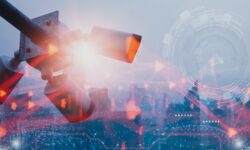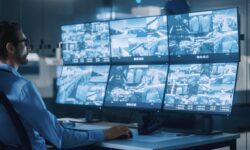The State of IT, Security and the Transportation Industry
These IP/IoT systems are here and customers are more keen to wanting integrated and unified platforms in order to see all of their systems under one hood.

(Image: AndSus/stock.adobe.com)
Long gone are the days of the analog system. Well, that is for the most part anyway, albeit that is a conversation for another day. Technology has evolved over the last decade in a multitude of ways, specifically here in the integrated security industry.
The Internet of Things (IoT) has given almost any imaginable product the ability to be connected to the Internet in some way, shape, or form. Yes, this even dives into our personal lives where your toaster, crockpot, oven and coffee maker can all be on “the network.”
This column will guide you through the current state of IT, security and the transportation/parking industry.
Point of No Return
Like it or not, the once disparate worlds of IT, security, transportation and parking are now intertwined in a way that cannot be undone. Whether you ride public transit or pay to park downtown for your hometown’s baseball team, IT and security are involved in the background even if you don’t notice them.
The trend of Big Data a decade ago has transformed merely into a norm in which entities are able to make better and more informed decisions today based upon a conglomerate of information that they have at their disposal. This includes data from your cellphone using Google or Apple Maps, paying for parking via an application on your phone, social media and beyond.
The same holds true to today’s current security systems that for the most part are IP-based. Regardless of whether the equipment or technology in question is access control, surveillance, intrusion detection, mass transit or license plate recognition (LPR), these systems are all IP-based, which puts them in the same IoT category as some of the home devices previously noted.
Integrators and end users must take into account cybersecurity implications as well as deploy practices to protect against attacks. Integrators are often faced today with conversations about cyber hardening given the current environment of cybersecurity attacks worldwide.
These IP/IoT systems are here to stay and are certainly not going to be retrograded back to the analog days. Customers are more keen to wanting integrated and unified platforms in order to see all of their systems under one hood, ultimately rendering them able to make more informed decisions from a security, safety and business perspective.
Transportation & Security Technologies
The transportation industry has often been forgotten in the security world. With IoT at scale, the old analog systems onboard buses, trains, and other transit vehicles are quickly being replaced with more intelligent and capable systems.
What used to be an analog system with onboard viewing only is now IP/IoT based where a security operations center (SOC) can view the cameras and vehicle status live, allowing for real-time decisions that affect vehicle operations, law enforcement, public safety, and beyond.
In addition to the original camera only approach, the new security platforms are capable of bringing in live vehicle data including telemetry, turn signals, braking and vehicle diagnostics — the possibilities are endless. These new systems even allow for operations managers to understand if the bus is off route or simply not operating at its full potential or capacity.
The parking industry still remains one of the few segments of the security industry where end users are able to measure a tangible cash return on investment while utilizing LPR systems. Many cities, counties and universities have moved towards a permit-less approach utilizing LPR in their jurisdictions.
This has allowed for tens of thousands of dollars saved in not purchasing vehicle hang tags. Additionally, the ability to combine mass transit, LPR and building-based video surveillance has helped many entities with customer complaints, internal human resource investigations, and greatly aided local law enforcement agencies as they conduct investigations surrounding a multitude of matters.
These technologies have morphed into their own being and allowed end users to provide a level of customized customer service like never seen before. Imagine pulling into a parking lot and having your name on the digital board greeting you. Or scanning your ID card on the bus and being greeted by the driver by name. We have come to an age where security is being utilized to help humanize the experience more and more on a daily basis regardless of where we go.
Customer Pain Points
One of the most resounding pain points we hear often from our customers is that they have many disparate systems that are no longer NDAA-complaint and do not meet Buy America requirements. There is a large push for both standards to be the norm in specifications here in the U.S. We often hear from many agencies that having disparate systems and proprietary equipment makes it challenging to make changes to their system. Additionally, the supply chain issues that the world is currently facing does not lend any assistance to the matter.
What our customers truly need is a partner and trusted advisor. Our customers rely on us as professionals in the integrated security space to be open and honest, even if that means acknowledging that the solution is not in their best interest.
They expect that we are working towards their best interests and not toward the bottom dollar, especially given that a multitude of these customers are government-based, either locally or federally. Regardless of the type of customer, it is imperative that we educate ourselves on the latest and greatest technologies to better understand when and where each technology may be able to resolve a pain point.
Return on Investment
Different entities will have a different take on what ROI means to them. Law enforcement and parking agencies will have a much more tangible ROI in terms of cash based upon parking violations, tickets, etc. when utilizing LPR systems. These same entities can also use the same technologies to gauge ROI in terms of customer satisfaction.
Utilizing LPR for both law enforcement and parking enforcement has helped many agencies create better traffic flows and ultimately a more friendly customer experience. The utilization of cameras on board city buses can aid law enforcement with legal matters in addition to assisting the bus company’s HR department with any type of customer complaints.
Many public transportation entities (such as airports) utilize international rating metrics in which one of the factors for consideration is the security and overall customer experience.
What is important to remember upfront is that we are all customer service agents of our organizations. Law enforcement, transit and parking agencies are always looking for ways to better the experience for their customers or at least the interactions that they have with them.
You can simply start by asking them what their pain points are to see if integrated security technologies may be able to assist them not only from a regulation or enforcement stance, but also from a customer service and quality perspective.
Elliott Gabriel is the Sales & Design Professional for Preferred Technologies.
If you enjoyed this article and want to receive more valuable industry content like this, click here to sign up for our FREE digital newsletters!

Security Is Our Business, Too
For professionals who recommend, buy and install all types of electronic security equipment, a free subscription to Commercial Integrator + Security Sales & Integration is like having a consultant on call. You’ll find an ideal balance of technology and business coverage, with installation tips and techniques for products and updates on how to add to your bottom line.
A FREE subscription to the top resource for security and integration industry will prove to be invaluable.







